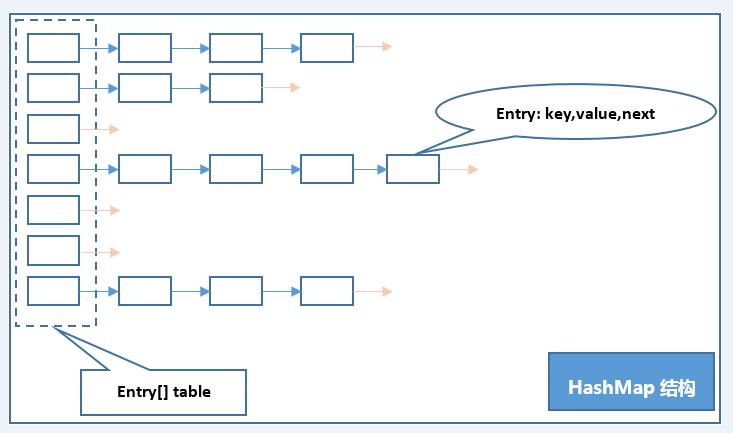HashMap 的一些認識: (JDK 1.7) 基於哈希表的Map介面的非同步實現,定義了鍵映射到值的規則 此實現提供所有可選的映射操作,並允許使用null值和null鍵 此實現假定哈希函數將元素適當分佈在各桶之間,為讀取操作提供穩定性能 迭代時間與實例容量(桶的數量)及其大小(鍵-值映射關係數) ...
HashMap 的一些認識: (JDK 1.7)
- 基於哈希表的Map介面的非同步實現,定義了鍵映射到值的規則
- 此實現提供所有可選的映射操作,並允許使用null值和null鍵
- 此實現假定哈希函數將元素適當分佈在各桶之間,為讀取操作提供穩定性能
- 迭代時間與實例容量(桶的數量)及其大小(鍵-值映射關係數)成正比
■ 類定義
public class HashMap<K,V> extends AbstractMap<K,V> implements Map<K,V>, Cloneable, Serializable
- 繼承 AbstractMap抽象類,實現了Map介面
- 實現 Cloneable介面
- 實現 java.io.Serializable 介面,支持序列化
HashMap - “鏈表散列” (數組+鏈表), 數組每一項都是一條鏈的數據結構

//The default initial capacity - MUST be a power of two. static final int DEFAULT_INITIAL_CAPACITY = 16; //The maximum capacity - MUST be a power of two <= 1<<30. static final int MAXIMUM_CAPACITY = 1 << 30; //The load factor used when none specified in constructor. static final float DEFAULT_LOAD_FACTOR = 0.75f; //The table, resized as necessary. Length MUST Always be a power of two. transient Entry<K,V>[] table; //The number of key-value mappings contained in this map. transient int size; //The next size value at which to resize (capacity * load factor). int threshold; //The load factor for the hash table. final float loadFactor; /** * The number of times this HashMap has been structurally modified * Structural modifications are those that change the number of mappings in * the HashMap or otherwise modify its internal structure (e.g., * rehash). This field is used to make iterators on Collection-views of * the HashMap fail-fast. (See ConcurrentModificationException). */ transient int modCount;
■ 構造器
public HashMap(int initialCapacity, float loadFactor) { if (initialCapacity < 0) throw new IllegalArgumentException("Illegal initial capacity: " + initialCapacity); if (initialCapacity > MAXIMUM_CAPACITY) initialCapacity = MAXIMUM_CAPACITY; if (loadFactor <= 0 || Float.isNaN(loadFactor)) throw new IllegalArgumentException("Illegal load factor: " + loadFactor); // Find a power of 2 >= initialCapacity int capacity = 1; while (capacity < initialCapacity) capacity <<= 1; this.loadFactor = loadFactor; //閾值為容量*負載因數和最大容量+1之間的最小值 以此值作為容量翻倍的依據(不能超過最大容量) threshold = (int)Math.min(capacity * loadFactor, MAXIMUM_CAPACITY + 1); //初始化一個2次冪的Entry類型數組 一個桶對應一個Entry對象 table = new Entry[capacity]; useAltHashing = sun.misc.VM.isBooted() && (capacity >= Holder.ALTERNATIVE_HASHING_THRESHOLD); init(); }
- Entry
/** * 靜態類 預設實現內部Entry介面 (介面中可定義內部介面-Map.Entry介面為Map的內部介面) * PS:JDK8中引入default,作用為在介面中定義預設方法實現 */ static class Entry<K,V> implements Map.Entry<K,V> { final K key;//key具有引用不可變特性 V value; Entry<K,V> next;//next指向下一個:單向鏈表,頭插入 final int hash; …… }
■ 主要方法
put(k, v)
/** * @return key不存在返回null,否則返回舊值 */ public V put(K key, V value) { //其允許存放null的key和null的value //當其key為null時,調用putForNullKey方法,放入到table[0]的這個位置(null鍵只有一個) if (key == null) return putForNullKey(value); //通過調用hash方法對key進行哈希,得到哈希之後的數值 //其目的是為了儘可能的讓鍵值對可以分不到不同的桶中 int hash = hash(key); //根據上一步驟中求出的hash得到在數組中是索引i int i = indexFor(hash, table.length); //如果i處的Entry不為null,則通過其next指針不斷遍歷e元素的下一個元素。 for (Entry<K,V> e = table[i]; e != null; e = e.next) { Object k;//使用臨時變數k主要用於e.key的賦值,意義有限 //hash一致 && (key引用相同 或 key字元串比較相同) if (e.hash == hash && ((k = e.key) == key || key.equals(k))) { //值變更 V oldValue = e.value; e.value = value; e.recordAccess(this); return oldValue;//已存在則選擇直接返回舊值 } } modCount++; addEntry(hash, key, value, i);//新增 return null;//若key不存在則返回null }
hash()
//JDK1.7 final int hash(Object k) { int h = 0; if (useAltHashing) { if (k instanceof String) { return sun.misc.Hashing.stringHash32((String) k); } h = hashSeed; } //異或就是兩個數的二進位形式,按位對比,相同取0,不同取一 //此演算法加入了高位計算,防止低位不變,高位變化時,造成的 hash 衝突 h ^= k.hashCode(); h ^= (h >>> 20) ^ (h >>> 12); return h ^ (h >>> 7) ^ (h >>> 4); } //JDK1.8 擾動函數 -> 散列值優化函數 static final int hash(Object key) { int h; //把一個數右移16位即丟棄低16為,就是任何小於2^16的數,右移16後結果都為0 //2的16次方再右移剛好就是1 同時int最大值為32位 //任何一個數,與0按位異或的結果都是這個數本身 //為indexFor做準備 return (key == null) ? 0 : (h = key.hashCode()) ^ (h >>> 16); }
indexFor()
/** * Int範圍(2^32)從-2147483648到2147483648,加起來大概40億空間,記憶體不能直接讀取 * 用之前還要先做對數組的長度取模運算,得到的餘數才能用來訪問數組下標 * @Param h 根據hash方法得到h * @Param length 一定是2次冪 */ static int indexFor(int h, int length) { //2次冪-1 返回的結果的二進位為永遠是都是1 比如 15 -> 1111 (16 -> 10000) //與運算 只有 1 & 1 = 1 正好相當於一個“低位掩碼” //如果length-1中某一位為0,則不論h中對應位的數字為幾,對應位結果都是0,這樣就讓兩個h取到同一個結果,hash衝突 //同時這個操作可以保證索引不會大於數組的大小(見開頭的描述) return h & (length-1); }
addEntry()
//該方法為包訪問 package java.util(本包私有性高於子類) void addEntry(int hash, K key, V value, int bucketIndex) { //當前容量超過閾值 && 當前坐標數組非空 //有個優雅的設計在於,若bucketIndex處沒有Entry對象,那麼新添加的entry對象指向null,從而就不會有鏈了 if ((size >= threshold) && (null != table[bucketIndex])) { resize(2 * table.length);//容量擴容一倍 hash = (null != key) ? hash(key) : 0;//hash重新計算 bucketIndex = indexFor(hash, table.length);//index重新計算 } createEntry(hash, key, value, bucketIndex);//新增Entry元素到數組的制定下標位置 } //該方法為包訪問 package java.util void createEntry(int hash, K key, V value, int bucketIndex) { // 獲取指定 bucketIndex 索引處的 Entry Entry<K,V> e = table[bucketIndex]; // 將新創建的 Entry 放入 bucketIndex 索引處,並讓新的 Entry 指向原來的 Entry // 形成鏈表,新加入的放入鏈表頭部,最先加入的放入尾部 table[bucketIndex] = new Entry<>(hash, key, value, e); size++; }
remove()
public V remove(Object key) { Entry<K,V> e = removeEntryForKey(key); return (e == null ? null : e.value); } /** * Removes and returns the entry associated with the specified key * in the HashMap. Returns null if the HashMap contains no mapping * for this key. */ final Entry<K,V> removeEntryForKey(Object key) { int hash = (key == null) ? 0 : hash(key); int i = indexFor(hash, table.length); Entry<K,V> prev = table[i];//用於記錄該key的前一個元素(預設先從隊首開始) Entry<K,V> e = prev;//從隊首開始往隊尾遍歷 //遍歷key所在鏈表 while (e != null) { Entry<K,V> next = e.next; Object k; if (e.hash == hash && ((k = e.key) == key || (key != null && key.equals(k)))) { modCount++;//remove屬於結構性改造,modCount計數+1 size--;//當前Map的有效元素數量-1 if (prev == e) table[i] = next;//若當前key正好位於隊首,則隊首指向next else prev.next = next;//若當前key不位於隊首,則該key之前的元素的next指向該key的下一個元素 e.recordRemoval(this);//LinkedHashMap專用方法 return e; } //繼續往隊尾找 prev = e;//指向當前迴圈元素的上一個元素 e = next;//指向下一次迴圈元素 } return e; }
■ HashMap 迭代
//方法一 Iterator<Map.Entry<Integer,Object>> it = map.entrySet().iterator(); while (it.hasNext()) { Map.Entry<Integer, Object> entry = it.next(); System.out.println("key=" + entry.getKey() + " and value=" + entry.getValue());
//在迭代中可刪除 Map 元素也是推薦,避免快速失敗 }
//方法二 for (Map.Entry<Integer,Object> entry : map.entrySet()) { System.out.println("key=" + entry.getKey() + " and value=" + entry.getValue()); }
***** 此版本為JDK 1.7,由於筆者水平有限,之後有補充的話會更新此文,請各位看客多多諒解支持 ********
***** JDK1.8 的 HashMap 之後會另寫一篇 ******


